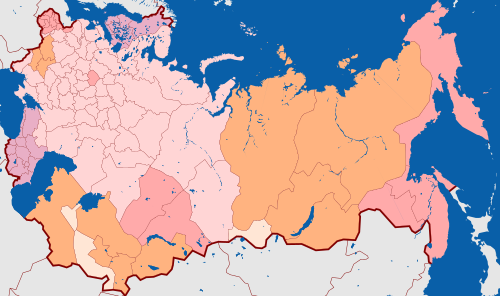Governorate (Russia)
This article has multiple issues. Please help improve it or discuss these issues on the talk page. (Learn how and when to remove these template messages)
|
| Governorates of the Russian Empire | |
|---|---|
| Category | Subdivision of a uezds (counties ) |
A governorate (Russian: губе́рния, romanized: guberniya, pre-1918 spelling: губе́рнія, IPA: [ɡʊˈbʲɛrnʲɪjə]) was a major and principal administrative subdivision of the Russian Empire. After the Bolshevik Revolution in 1917, governorates remained as subdivisions in the Byelorussian, Russian and Ukrainian Soviet republics, and in the Soviet Union from its formation in 1922 until 1929. The term is also translated as government or province. A governorate was headed by a governor (губернатор, gubernator), a word borrowed from Latin gubernator, in turn from Greek kyvernítis (Greek: κυβερνήτης).
Selected governorates were united under an assigned governor-general such as the Grand Duchy of Finland, Congress Poland, Russian Turkestan and others. There were also military governors such as Kronstadt, Vladivostok and others. Aside from governorates, other types of divisions were oblasts (region) and okrugs (district).
First reform

This subdivision type was created by the edict (
Second reform
In 1719, governorates were further subdivided into provinces (
| Governorates of the Russian Empire (1708-1726) | ||||||||||||||||||
| 1708-1710 | Kazan | Ingermanland
|
Azov | Smolensk | ||||||||||||||
| 1710-1713 | Saint Petersburg | |||||||||||||||||
| 1713-1714 | Moscow | Riga | ||||||||||||||||
| 1714-1717 | Nizhny Novgorod | |||||||||||||||||
| 1717-1719 | Astrakhan | |||||||||||||||||
| 1719-1725 | Nizhny Novgorod | Reval | ||||||||||||||||
| 1725-1726 | Voronezh | |||||||||||||||||
| 1726 | Smolensk | |||||||||||||||||
| The Governorates of Siberia remained constant between 1708 and 1726.
| ||||||||||||||||||
Changes from 1775: Namestnichestvo (Vice royalty)

By the reform of 1775, subdivision into governorates and further into
By the ukase of the
Governorates in Poland and Finland
The governorate (Russian: губе́рния, Polish: gubernia, Swedish: län, Finnish: lääni) system was also applied to subdivisions of the Kingdom of Poland ("Russian Poland") and the Grand Duchy of Finland.
Post-revolutionary changes
After the February Revolution, the Russian Provisional Government renamed governors into governorate commissars. The October Revolution left the subdivision in place, but the governing apparatus was replaced by governorate soviets (губернский совет).
Actual subdivisions of the Soviet Union into particular territorial units was subject to numerous changes, especially during the 1918–1929 period. Because of the Soviet Union's electrification program under the
In post-Soviet states such as Russia and Ukraine, the term Guberniya is considered obsolete, yet the word gubernator was reinstated and is used when referring to a governor of an oblast or a krai.
Governorates in Ukraine
The Russian Empire had nine governorates in modern-day Ukrainian territories:
After the events of 1917, which led to the declaration of independence of the
The West Ukrainian People's Republic in former Austro-Hungarian Empire territory was not subdivided into governorates, and would be annexed by the Second Polish Republic from 1920 until the Soviet invasion of 1939.
Other uses
There is another meaning of the word as it denoted a type of estate in Lithuania of the until 1917.
See also
- History of the administrative division of Russia
- List of governorates of the Russian Empire
- Governorate-General (Russian Empire)
References
External links
- (in Russian) Ignatov, V.G. "History of state administration of Russia" (История государственного управления России) Archived 2019-12-23 at the Wayback Machine
- (in Russian) Иванов В. В. Глава субъекта Российской Федерации. История губернаторов. Том I. История. Книга I. — М., 2019. — 600 с.
- (in Russian) Иванов В. В. Глава субъекта Российской Федерации. История губернаторов. Том I. История. Книга II. — М., 2019. — 624 с.
